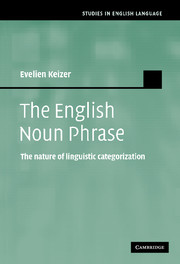Book contents
- Frontmatter
- Contents
- Acknowledgements
- 1 Introduction
- PART I The structural approach: possibilities and limitations
- PART II The cognitive-pragmatic approach: some applications
- 9 The flexibility of language
- 10 Complements and modifiers
- 11 Discontinuous NPs
- 12 Possessive constructions: the author's opinion versus the opinion of the author
- 13 Conclusions
- Bibliography
- Author index
- Subject index
10 - Complements and modifiers
Published online by Cambridge University Press: 25 January 2010
- Frontmatter
- Contents
- Acknowledgements
- 1 Introduction
- PART I The structural approach: possibilities and limitations
- PART II The cognitive-pragmatic approach: some applications
- 9 The flexibility of language
- 10 Complements and modifiers
- 11 Discontinuous NPs
- 12 Possessive constructions: the author's opinion versus the opinion of the author
- 13 Conclusions
- Bibliography
- Author index
- Subject index
Summary
Introduction
A large amount of research on the NP has been devoted to the question of whether it is justified and feasible to distinguish two basic types of noun: those that take complements (often referred to as relational nouns) and those that do not (non-relational nouns). Relational nouns are often compared to verbs in that, like verbs, they have an argument structure and impose restrictions on the number, semantic roles and semantic features of their arguments. This is particularly clear in deverbal nouns, which not only share their denotation with the input verb, but which may also be said to ‘inherit’ the argument structure of this verb.
There are, however, important differences as well. Thus, not all nouns take arguments; as a matter of fact, only a minority of nouns take one or more arguments. This is no doubt related to the fact that nouns and verbs differ with regard to the roles they typically perform within the clause: whereas verb frames can be seen as the skeleton of the clause, specifying the type of action, the number of participants and the roles they play, nouns are typically used to refer to these participants. Moreover, the arguments of verbs are obligatory (or virtually so) and share specific formal features; the arguments of nouns, on the other, can easily be omitted and are not characterized by consistent formal marking.
- Type
- Chapter
- Information
- The English Noun PhraseThe Nature of Linguistic Categorization, pp. 218 - 263Publisher: Cambridge University PressPrint publication year: 2007



